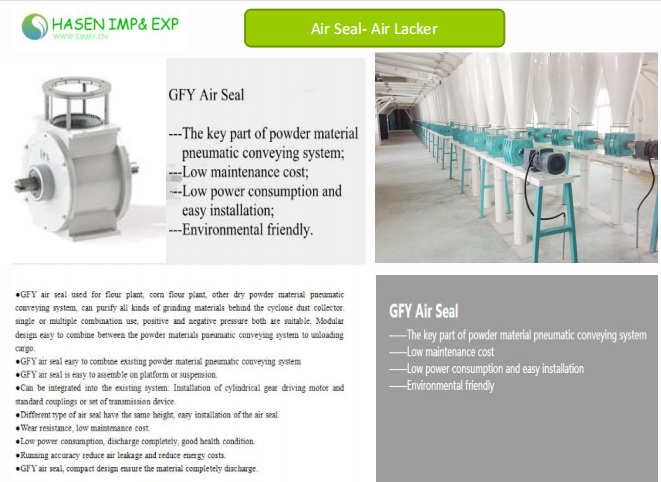Application of Flour Blending in Wheat Processing-2
Edit by: www.immy.cn www.immyhitech.com
The cement surface of the inner wall of the warehouse should be polished and smoothed, and the waterproof coating (model JH80-2) should be evenly applied 3~5 times to keep it smooth and not stick to the flour. Because the fluidity of the flour is very poor, if the ordinary silo bucket is used, the flour is difficult to flow out, so the silo body is basically cylindrical, and the bottom of the cylinder is a circular outlet and the bottom of the silo is vibrated by the device.

The bulk storage bin should be provided with a dust explosion vent and an explosion pressure relief plate. When the energy pressure of the warehouse reaches 15 kPa, the step-down plate should be blasted, and the area of the step-down plate should be 0.02~0.04 m2 per cubic meter of warehouse capacity.
Level meters should be set up above and below the bin to show whether the bin is full or empty.
The flow angle of the silo bottom should be 75 ° ~ 80 °, and the flow angle of the square conical bin bottom should be subject to the ridge angle intersecting with the plane, and at the same time, install the bin bottom discharger to help unload(www.immy.cn).
In order to prevent flour pollution, the powder silo is generally not equipped with ladders, and the lifting ring is embedded on the roof directly above the inspection hole of the powder silo during construction, and the suspension pulley enters when it is necessary to check.
The alpine areas of northern China mainly include Heilongjiang, Jilin, Liaoning, Inner Mongolia, Ningxia and Gansu and other provinces and regions. The silo body must be thickened and insulated hollow bricks must be used, and the flour cooling and exhaust and humidity in the silo should be considered when using positive pressure to convey into the warehouse. The flour is cooled by a straight pipe section with double casing counterflow cooling.

The scattering of wheat flour requires a large angle, generally above 75°, but due to the poor scattering of flour, bridging and arching are still inevitable. Therefore, the self-slipping of the powder silo is not suitable for automatic continuous production. The vibrating discharger at the bottom of the silo vibrates or forms a "fluidized" effect at the bottom of the silo to ensure automatic continuous production.
4.2 Vibrating the bottom of the bin
The vibrating bin bottom (also known as the vibrating bin bottom discharger) is composed of an outlet base, a hanging mechanism, a bin bucket and a vibrating motor. The outlet base is installed at the bottom of the bunker. The bin bucket is hung under the base by a boom, and the rubber soft sleeve is used to connect with the upper and lower interfaces, and the bin bucket can produce free vibration along the horizontal direction.
Under the impetus of the vibrating motor, the silo bucket produces forced vibration, so that the materials in the silo bucket flow out smoothly, because the silo is full of flour, the damping effect on the vibration is greater(www.immy.cn).
Therefore, a larger vibrating motor must be used to provide sufficient side power. There is also a decompression homogenizing umbrella above the outlet of the silo bucket to eliminate the direct impact of the pressure of the material in the silo on the outlet, so as to facilitate the uniform flow of flour. The outlet of the bin bucket is large (about 500 mm), and it is generally softly connected to the inlet of the conveying equipment through the conical bucket.
4.3 Flour scale
The flour weighing is the weight reduction batch batching system, which is composed of a feeding mechanism, a weighing hopper, a weighing module and a control system, and the feeding mechanism is controlled by the feedback signal of the weighing module, and when the target weight is reached, the feeding mechanism stops moving, and the batching work is completed(www.immy.cn).
.png)
According to the size of the weighing hopper, it can be divided into batch scale (500~3 000 kg/batch), medium scale (200~500 kg/batch), and micro scale (≤200 kg/batch). There are various forms of feeding mechanism, there are valves (large and small valves), screw conveyors, rotary valves and vibrating conveyors and other mechanisms, as for the selection of which feeding mechanism depends on the nature of the material and the required weighing accuracy, the industry to screw conveyor as the feeding mechanism is the most common, because the screw feeding is uniform and easy to control.
5,Positive pressure pneumatic conveying
Positive pressure pneumatic conveying is to rely on the gas pressure generated by the compressed air machinery to transport the material to a certain height and position. The material conveying is done in the positive pressure section of the compressor machine, and the general compressor machine is the roots blower.
5.1 The principle of positive pressure pneumatic conveying
Positive pressure pneumatic conveying is a technology that uses an air flow with a certain speed and positive pressure to transport bulk materials through pipelines. The flow of air forms the wind, so it is also called wind luck or wind delivery. According to the nature of the material, the conveying distance can be from a few meters to thousands of meters, and the conveying output can reach nearly 100 tons per hour.
5.1.1 Aerodynamic properties of material particles
The aerodynamic properties of material particles mainly refer to the suspension velocity. The suspension velocity reflects the main physical characteristics of the conveyed material, and its numerical magnitude is determined by the density, particle size, shape, surface state, pipe diameter, air density and other factors of the material.

Wuxi Hasen Import And Export Co.,Ltd
Contact:Amina Zhu
Mobile:+8613812016908
Email:amina@immyhitech.com
Add:#68,Xindongan Rd,Xinwu Distt,Wuxi,Jiangsu,China 214000